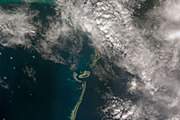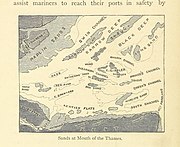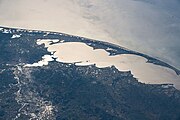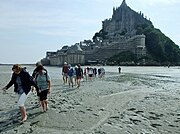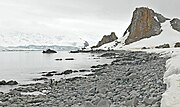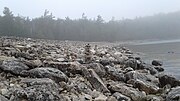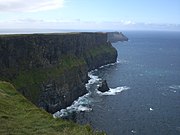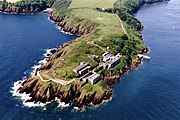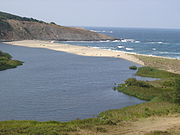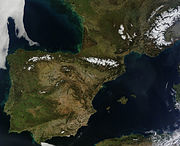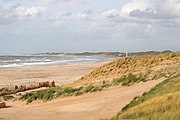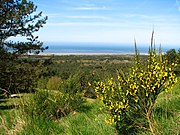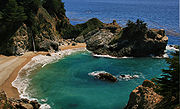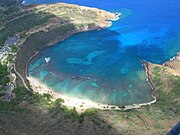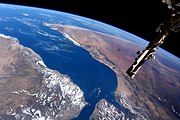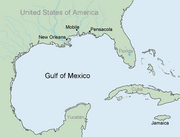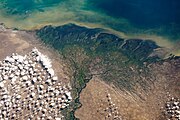Coastal landforms
type of landform | |||||
| Upload media | |||||
| Subclass of | |||||
|---|---|---|---|---|---|
| Part of | |||||
| Facet of | |||||
| |||||
Rocks sticking out of the sea[edit]
Stacks[edit]
A stack is a geological landform consisting of a steep and often vertical column in the sea near a coast, formed by wave erosion.
-
Apostles, Australia
-
Old man of Hoy, Scotland, UK
Land under sea[edit]
Reefs[edit]
A reef is a bar of rock, sand, coral or similar material, lying beneath the surface of water.
-
Johnston Island, Pacific Ocean
-
New Caledonia coast, reef and mouth of river La Néra
Shoals[edit]
A shoal or sandbar (also called sandbank) is a somewhat linear landform within or extending into a body of water, typically composed of sand, silt or small pebbles.
-
Sandbanks in the mouth of the Thames, North Sea
-
Nordfriesland, Germany
-
Uruguay, near Pando Creek
Lagoons[edit]
A lagoon is a shallow body of water separated from a larger body of water by barrier islands or reefs.
-
Lagos dos Patos, Brazil
-
Venice, Italy
Tidal landforms[edit]
Mudflats[edit]
Mudflats are coastal wetlands that form in intertidal areas where sediments have been deposited by tides or rivers.
-
Saint Malo (France) - low tide
-
Saint Malo (France) - high tide
-
Mont Saint-Michel (France) - low tide
-
Mont Saint-Michel (France) - high tide
-
Waddenzee (Netherlands) - low tide
Beaches[edit]
A beach is a landform alongside a body of water which consists of loose particles, such as sand, gravel, shingle, pebbles.
Sand and pebble beaches[edit]
-
Sand beach in the Netherlands
-
Beach with sand and cobbles in Ecuador
-
Cobble beach in England, UK
Boulder beaches[edit]
-
South Shetland Islands, Antarctica
-
West Bengalen
Rock beaches[edit]
-
Bruce Peninsula National Park, Canada
-
Solidified lava on the beach of Pico, Azores
-
Ulko-Tammio, Finland
Wave-cut platforms[edit]
A wave-cut platform is a narrow flat area that was created by erosion.
-
South Wales, UK
-
Étretat, France
Sea cliffs[edit]
A sea cliff is a form of coast where the action of marine waves has formed steep cliffs.
-
Cliffs of Moher, Ireland
-
Étretat, France
Wave-cut notches[edit]
Wave-cut notches are created by waves at the base of a cliff.
-
Étretat, France
-
Bonifacio, Corsica, France
Headlands[edit]
A headland is a narrow strip of land, largely surrounded by water.
-
Turquoise Coast, Turkey
-
Wales, UK
Spits[edit]
A spit or sandspit is a deposition bar or beach landform off coasts or lake shores.
-
Veleka, Black Sea, Bulgarije
-
Farewell Spit, New Zealand
Capes[edit]
A cape is a headland or a promontory of large size extending into a body of water, usually the sea.
-
Lopatka Cape, Russia
-
Cape Ose, Japan
Peninsulas[edit]
A peninsula is a landform surrounded by water on the majority of its border while being connected to a mainland from which it extends.
-
Iberian Peninsula, (Portugal & Spain)
-
Arabian Peninsula (map, 1606)
-
Korean Peninsula
Coastal dunes[edit]
A coastal dune is a hill of loose sand built by aeolian processes (wind) or the flow of water, along the coast.
-
The Netherlands
-
Germany
-
France
Inlets[edit]
An inlet is an indentation of a shoreline. From small to big:
Coves[edit]
A cove is a small type of bay.
-
California, USA
-
Bulgaria
Bays[edit]
A bay is a part of a sea or ocean that invades the land.
-
Italy
-
Honolulu, Hawaï
-
Spain
Calanques[edit]
A calanque is a steep-sided valley formed within karstic regions.
-
France
-
France
-
France
Fjords[edit]
A fjord is a long, narrow inlet with steep sides or cliffs, created by a glacier.
-
Geirangerfjord, Norway
-
Trollfjord, Norway
-
Aurlandsfjord, Norway
Gulfs[edit]
A gulf is a large inlet from the ocean into the landmass, up to more than 100 km.
-
Gulf of Bothnia, Gulf of Finland, Gulf of Riga
-
Gulf of Aden
-
Gulf of Mexico
-
Gulf of Venezuela
Rivers at coasts[edit]
River mouths[edit]
A river mouth is the part of a river where the river debouches into a sea or an ocean.
-
Palmiet, South Africa
-
Uggerby A, Danmark
-
Arroyo Chuy, Uruguay
Estuaries[edit]
An estuary is a partially enclosed coastal body of brackish water with one or more rivers or streams flowing into it, and with a free connection to the open sea.
-
Estuary mouth
-
Rio Geba, Guinee-Bissau
-
Ilha de Marajó, Brazil
-
Barrow Harbour, Ireland (low tide)
River deltas[edit]
A river delta is a system of branches of a river before it flows into the sea or into a large lake.
-
Alaska, USA
-
Amazon Delta, Brazil
-
Indus River Delta, Pakistan
-
Volga Delta, Russia






